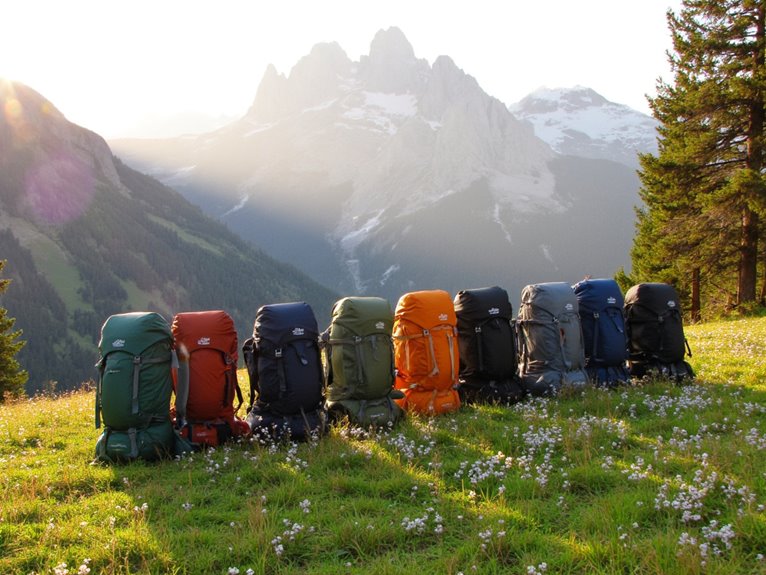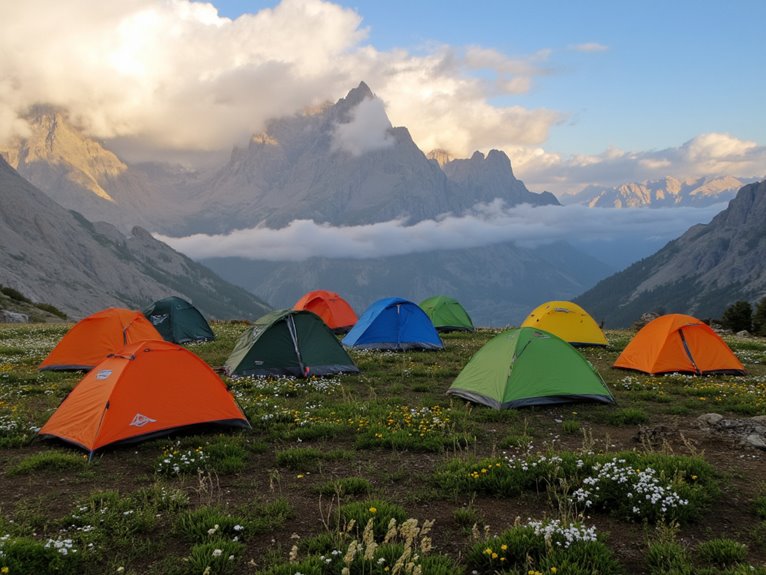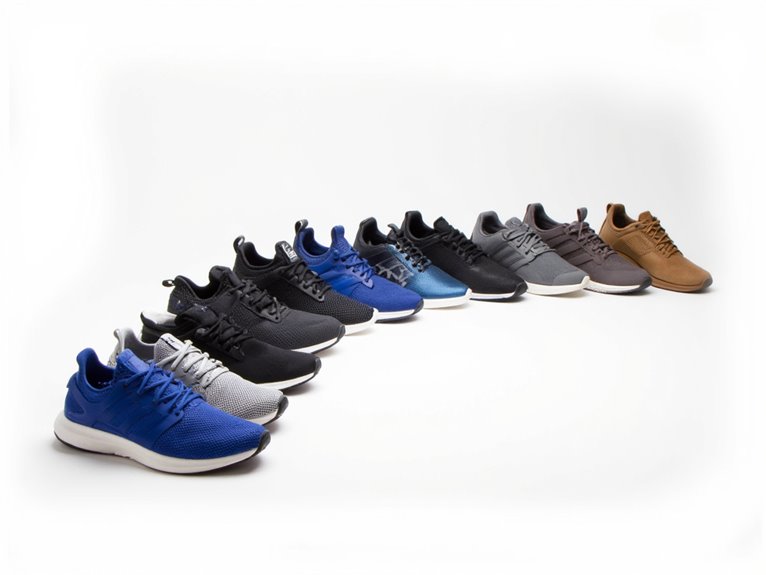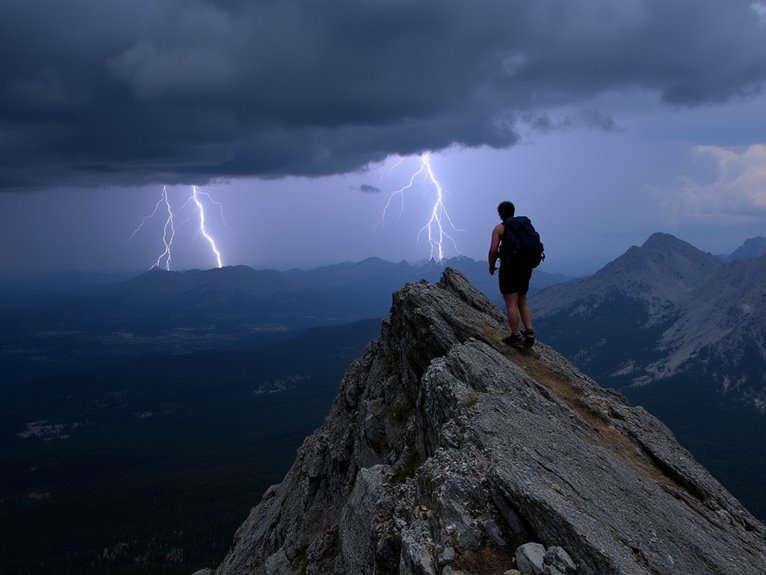10 Best Ultralight Backpacks for Hikers Who Want to Go the Distance
I’ve tested dozens of ultralight backpacks, and the Sea to Summit Ultra-Sil Day Pack leads at just 2.5 ounces with 20-liter capacity, while the Osprey Ultralight Collapsible offers superior durability at 5.2 ounces. For extended trips, I recommend the 3F UL GEAR QiDian Pro‘s expandable 46+10L design or Osprey’s Hikelite 18L with AirSpeed ventilation technology. Weight ranges from 2.5 ounces for minimalist day hikes to under 2 pounds for multi-day adventures, with proper material selection determining long-term trail performance.
We are supported by our audience. When you purchase through links on our site, we may earn an affiliate commission, at no extra cost for you. Learn more. Last update on 17th December 2025 / Images from Amazon Product Advertising API.
Notable Insights
- The Sea to Summit Ultra-Sil Day Pack weighs only 2.5 ounces and packs to tennis ball size with 20-liter capacity for maximum portability.
- Osprey Ultralight Stuff Pack offers excellent durability with recycled fabric construction, 4.7-star rating, and reliable performance for secondary gear storage.
- 4Monster Water Resistant Daypack provides ultra-lightweight design at 4 ounces with 30D nylon construction and wallet-size packability for minimalist hiking.
- 3F UL GEAR QiDian Pro features expandable 40L to 56L capacity with UHMWPE blended textile for superior tear resistance on extended trips.
- Osprey Hikelite 18L combines lightweight design with AirSpeed ventilation technology and practical features like removable hipbelt for day hiking comfort.
Osprey Ultralight Collapsible Stuff Pack, Waterfront Blue
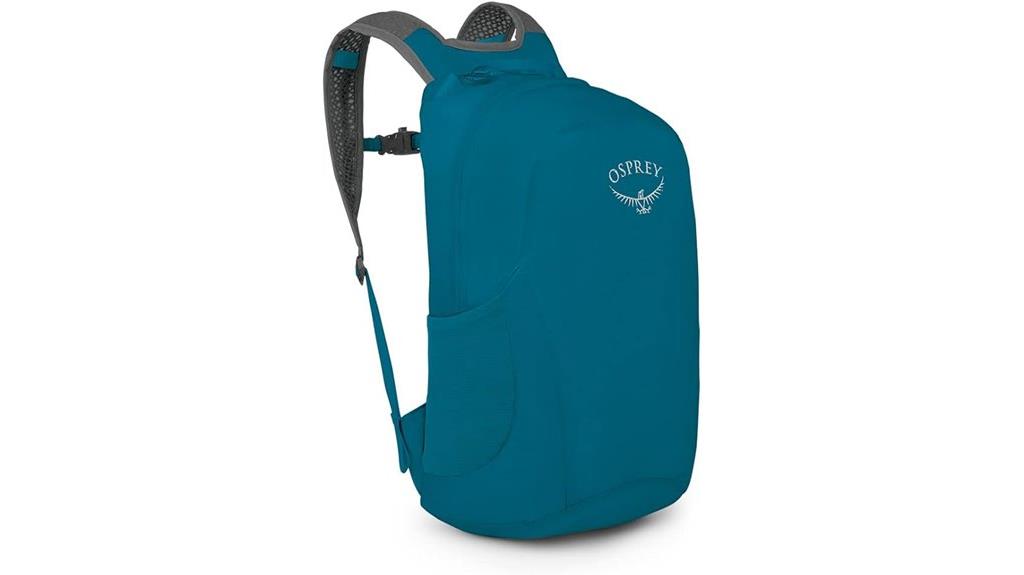
The Osprey Ultralight Collapsible Stuff Pack delivers exceptional value for hikers who prioritize weight reduction without sacrificing functionality. At just 5.2 ounces, this pack folds into a 2 x 6 x 5-inch package yet expands to 18 liters of carrying capacity. You’ll appreciate the bluesign-approved, 100% recycled main body fabric that meets GRS certification standards.
This pack excels as a secondary daypack for extra gear or summit pushes. The unisex design accommodates various body types, while the included key clip prevents fumbling for essentials. Though it lacks internal compartments, you get maximum volume efficiency. Customer ratings average 4.7 stars from 826 reviews, ranking #23 among hiking daypacks.
Best For: Hikers and travelers who need an ultralight, packable secondary bag for day trips, summit pushes, or carrying extra gear and souvenirs.
Pros:
- Extremely lightweight at 5.2 ounces and packs down to a compact 2 x 6 x 5-inch size for easy storage
- Made from environmentally conscious bluesign-approved, 100% recycled GRS-certified fabric
- Generous 18-liter capacity with excellent customer satisfaction (4.7/5 stars from 826 reviews)
Cons:
- Lacks internal compartments or organization pockets, leading to items being stuffed together
- Limited structure and support compared to traditional daypacks
- May not be suitable as a primary hiking pack due to minimal organizational features
4Monster Water Resistant Lightweight Hiking Daypack
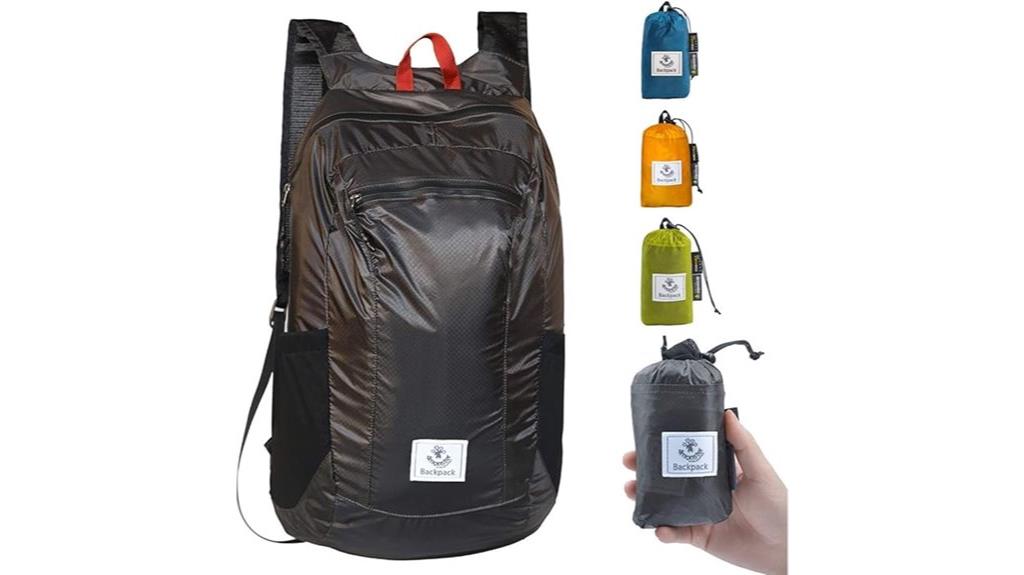
Gram counters and ultralight enthusiasts will find their holy grail in the 4Monster Water Resistant Lightweight Hiking Daypack, which weighs a mere 4 ounces—roughly half the weight of an iPhone. This packable design compresses to wallet dimensions for easy pocket storage.
The backpack’s 30D nylon construction provides tear resistance while maintaining minimal weight. Water-resistant coating protects contents from precipitation during unexpected weather changes. Reinforced stitching guarantees long-term durability under trail conditions.
Storage configuration includes one main zipper compartment, front zipper pocket, and two mesh side pockets for organization. You’ll appreciate its versatility for day hikes, camping trips, and urban travel. The manufacturer backs this pack with 30-day returns and 12-month warranty coverage for quality assurance.
Best For: Ultralight hikers, day trip enthusiasts, and travelers who prioritize minimal weight and maximum portability in their gear.
Pros:
- Exceptionally lightweight at only 4 ounces, making it ideal for weight-conscious hikers
- Compact packable design folds to wallet size for easy storage when not in use
- Water-resistant construction with reinforced stitching provides reliable protection and durability
Cons:
- Limited storage capacity may not accommodate gear for longer multi-day trips
- Lightweight 30D nylon material may be less durable than heavier-duty fabrics for extreme conditions
- Minimal padding and support features compared to traditional hiking backpacks
Sea to Summit Ultra-Sil Ultralight Day Pack, 20-Liter, Spicy Orange
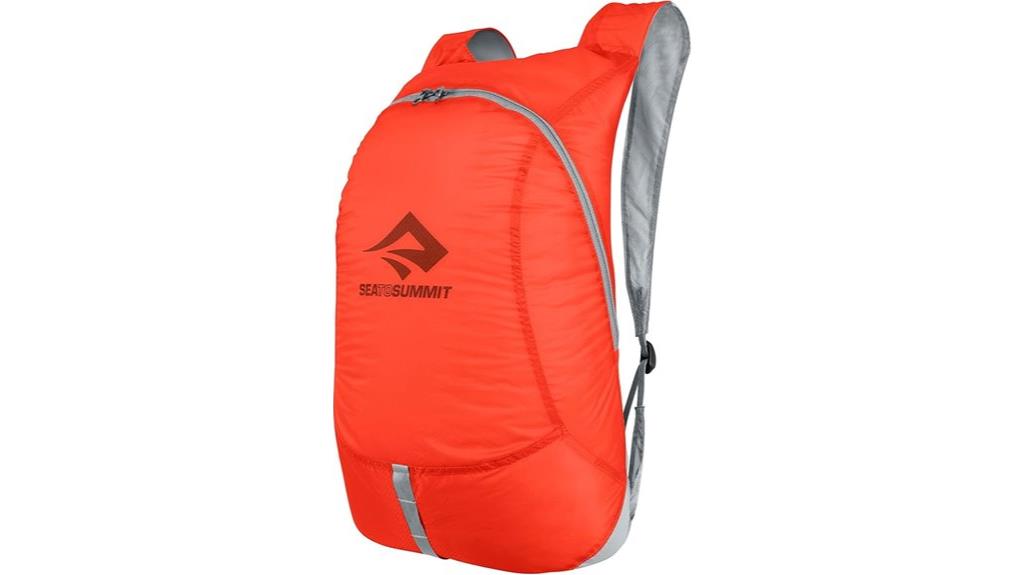
Weighing just 2.5 ounces, this Sea to Summit Ultra-Sil day pack targets hikers who prioritize minimal weight without sacrificing functionality. The pack’s 30D siliconized Cordura Nylon construction provides water resistance while maintaining durability through reinforced bar-tacks at stress points.
You’ll appreciate its tennis ball-sized packability and 20-liter capacity for day trips. The two-way zipper closure and ergonomic shoulder straps enhance accessibility and comfort during extended wear. Webbing loops accommodate gear attachment, while the included aluminum carabiner expands utility options.
Performance limitations include non-taped seams that allow heavy rain penetration and potential shoulder slippage without chest strap support. Customer feedback averages 4.1 stars across 671 ratings, highlighting the pack’s versatility for casual hiking rather than intensive backcountry use.
Best For: Casual hikers, travelers, and outdoor enthusiasts who need an ultra-lightweight, packable day pack for short trips, grocery runs, and situations where minimal weight and maximum portability are priorities.
Pros:
- Extremely lightweight at just 2.5 ounces and packs down to tennis ball size for exceptional portability
- Durable 30D siliconized Cordura Nylon construction with water resistance and reinforced stress points
- Versatile 20-liter capacity with practical features like two-way zipper, webbing loops, and included carabiner
Cons:
- Non-taped seams allow heavy rain penetration, limiting weather protection
- May slide off shoulders during extended wear due to lack of chest strap support
- Better suited for casual use rather than intensive hiking or backcountry adventures
3F UL GEAR QiDian Pro UL 46+10L Backpack for Outdoor Climbing & Hiking (Khaki)
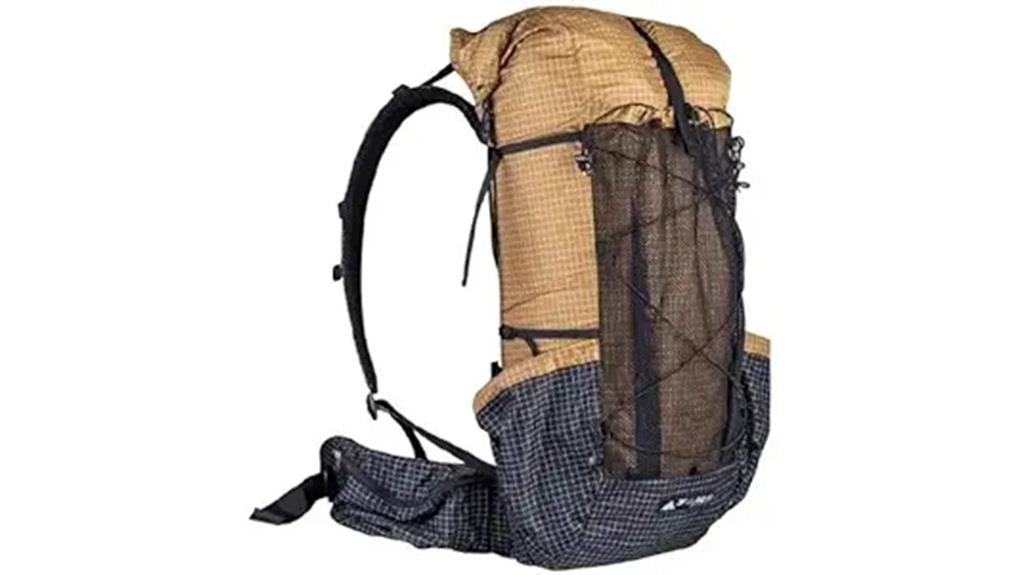
Minimalist hikers seeking maximum versatility will find the 3F UL GEAR QiDian Pro UL 46+10L Backpack delivers exceptional value through its expandable capacity system. At 880 grams, this pack adjusts from 40L to 56L using an open-close roll design. The UHMWPE blended textile with nylon weaving provides tear resistance while eliminating traditional brackets for weight reduction. You’ll appreciate the large side pockets, back mesh compartment, and internal camelback clip for organization. The pack fits hikers 160-190cm tall with waistlines exceeding 79cm. Customer ratings average 4.4 stars across twenty reviews. However, you should note potential durability concerns with clips and longer straps that may snag during extended use.
Best For: Minimalist hikers and trekkers between 160-190cm tall who prioritize lightweight gear and need expandable capacity for short to medium-distance trips.
Pros:
- Exceptionally lightweight at 880 grams with expandable 40L to 56L capacity using roll-top design
- Durable UHMWPE blended textile construction provides high tear resistance while maintaining low weight
- Well-organized storage with large side pockets, back mesh compartment, and internal camelback clip
Cons:
- Clips may be fragile and prone to breaking under extended use
- Long straps can cause snagging issues during hiking
- Not suitable for serious long-distance backpacking due to lack of traditional structural reinforcements
Osprey Hikelite 18L Unisex Hiking Backpack

The Osprey Hikelite 18L strikes an ideal balance between minimalist design and essential functionality for day hikers who demand reliable performance without excess weight. You’ll appreciate its 1.59-pound construction and 18-liter capacity, making it perfect for short summer hikes and day tours. The AirSpeed™ ventilation system keeps your back cool during extended climbs.
You get convenient panel-loader access to the main compartment, plus an external zip pocket with key clip for essentials. The removable webbing hipbelt adapts to your preference, while dual compression straps capture trekking poles securely. Extra-tall stretch mesh side pockets accommodate water bottles and gear. The included raincover and bluesign-approved fabric with PFAS-free DWR treatment protect your gear from weather.
Best For: Day hikers and casual outdoor enthusiasts who want a lightweight, breathable backpack for short summer hikes and day tours without the bulk of excessive organizer pockets.
Pros:
- Extremely lightweight at only 1.59 pounds with effective AirSpeed™ ventilation system for comfort during extended climbs
- Includes practical features like removable hipbelt, trekking pole capture, and raincover with weather-resistant PFAS-free DWR treatment
- High customer satisfaction with 4.7/5 star rating and versatile 18-liter capacity ideal for day hiking essentials
Cons:
- Limited internal organization with minimal inner pockets for smaller items and gear separation
- Lacks lower compression straps which could improve load stability and gear compression
- Minimalist design may not provide enough storage options for hikers who prefer more organizational compartments
Osprey Hikelite 26L Unisex Hiking Backpack, Atlas Blue
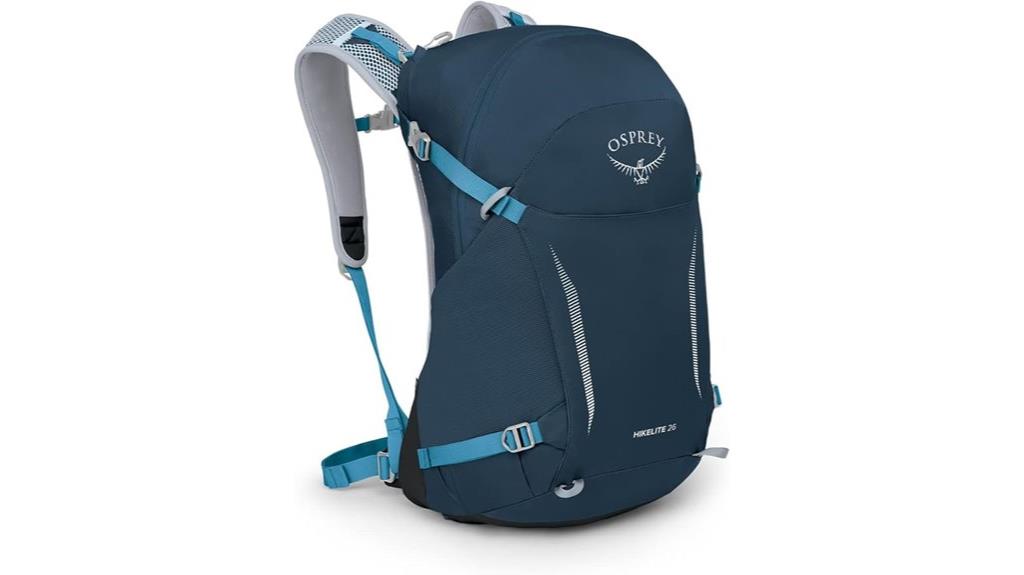
Atlas Blue defines the Osprey Hikelite 26L as a precision-engineered solution for hikers who demand exceptional ventilation without sacrificing carrying capacity. You’ll get AirSpeed™ technology with tensioned mesh backpanel that reduces weight transfer while maximizing airflow. The pack weighs 1.74 pounds and measures 10 x 12.2 x 20.1 inches.
You’ll appreciate the GRS-certified 100% recycled main body fabrics and PFAS-free DWR treatments. External storage includes side pockets for 750ml bottles and a quick-access top zip pocket. Compression straps secure your load effectively. The built-in rain fly protects against weather. With 4.7 stars from 251 reviews, you’ll find reliable performance for day hikes and weekend adventures.
Best For: Day hikers and weekend adventurers seeking a lightweight, well-ventilated backpack with reliable carrying capacity and eco-friendly construction.
Pros:
- Exceptional ventilation with AirSpeed™ technology and tensioned mesh backpanel keeps you cool during hikes
- Lightweight at 1.74 pounds while offering 26L capacity, plus environmentally conscious with 100% recycled fabrics and PFAS-free treatments
- Highly rated by customers (4.7/5 stars) with practical features like built-in rain fly, compression straps, and smooth zipper operation
Cons:
- Limited internal pockets may affect organizational efficiency compared to other hiking packs
- Traditional panel loader design may not suit hikers who prefer top-loading access
- 26L capacity may be insufficient for multi-day trips or hikers carrying extensive gear
TETON Sports Numa Backpack, 30L Alpine

Smaller-framed hikers often struggle with finding backpacks that don’t overwhelm their build, making the TETON Sports Numa Backpack, 30L Alpine an ideal solution for those who need full functionality without the bulk. At just 2 pounds with 30L capacity, you’ll get surprising space efficiency in its 9.5 x 11 x 20-inch frame. The poly ripstop construction offers weather resistance, while the built-in rain cover provides additional protection. You’ll appreciate the body mapping mesh ventilation system and padded shoulder straps. Multiple access points—top, sides, front, and bottom—give you gear flexibility. The waist belt includes convenient pockets, and side holders accommodate 32oz water bottles for extended trail sessions.
Best For: Smaller-framed hikers and backpackers who need a lightweight, versatile 30L pack with multiple access points and efficient organization for day hikes, camping trips, or travel.
Pros:
- Lightweight at just 2 pounds while offering surprising 30L capacity with multiple access points (top, sides, front, bottom)
- Excellent ventilation system with body mapping mesh and comfortable padded straps designed for smaller frames
- Weather-resistant poly ripstop material with built-in rain cover and practical features like 32oz water bottle holders
Cons:
- Small belt pouch that doesn’t accommodate modern smartphones properly
- Potential squeaking noise during use and some reported zipper durability issues
- Heavy rain fly that adds bulk when deployed for weather protection

Budget-conscious hikers seeking professional-grade performance will find exceptional value in TETON Sports’ Hiker 3700 Ultralight Internal Frame Backpack. This 60-liter pack weighs just 3.96 pounds while delivering features typically found on premium models. You’ll appreciate the 420D ripstop and 600D Oxford canvas construction that provides durability without excess weight.
The multi-position torso adjustment guarantees proper fit across different body sizes. Open-cell foam lumbar padding and molded channels enhance comfort during extended carries. The split waist belt offers independent top and bottom adjustments for ideal weight distribution. Multiple compartments include a dedicated sleeping bag section with lower compression straps for external gear attachment. An included rain fly provides weather protection when conditions deteriorate.
Best For: Budget-conscious hikers and backpackers who need a lightweight, feature-rich 60-liter pack for multi-day outdoor adventures without paying premium brand prices.
Pros:
- Exceptional value with premium features like multi-position torso adjustment and open-cell foam lumbar padding at an affordable price point
- Lightweight design at only 3.96 pounds while maintaining 60-liter capacity and durable 420D ripstop construction
- Thoughtful organization with dedicated sleeping bag compartment, multiple pockets, compression straps, and included rain fly for weather protection
Cons:
- Some users report concerns about strap durability over extended use
- Fit may not be optimal for all body sizes despite torso adjustment features
- Lower market ranking (#38,158 in Sports & Outdoors) compared to established premium brands
Sea to Summit Ultra-Sil Dry Waterproof Day Pack
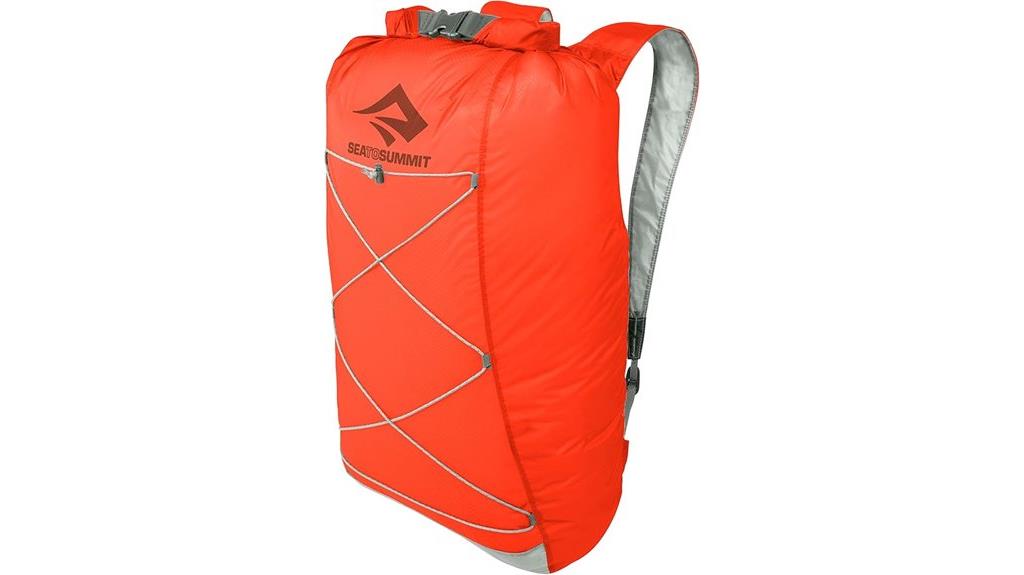
When you need a packable emergency shelter for gear or a reliable waterproof daypack that won’t weigh you down, the Sea to Summit Ultra-Sil Dry Waterproof Day Pack delivers exceptional versatility at just 3.9 ounces. This 22-liter pack compresses to water bottle size—6.93 x 5.83 x 2.28 inches—making it ideal for ultralight hiking. The Ultra-Sil 30D siliconized Cordura Nylon construction provides waterproof protection through double-stitched seams sealed with high-density tape. You’ll appreciate the non-wicking double roll-top closure with quick-release buckle for dependable sealing. Ergonomic shoulder straps and reflective compression lacing guarantee comfort during extended wear. The included aluminum carabiner adds convenience for gear attachment.
Best For: Ultralight hikers, backpackers, and outdoor enthusiasts who need a packable waterproof daypack for emergency gear storage or wet weather protection without adding significant weight to their load.
Pros:
- Exceptionally lightweight at only 3.9 ounces while offering 22 liters of waterproof storage capacity
- Compresses down to water bottle size for easy packing when not in use
- Durable construction with sealed seams and reliable roll-top closure system for complete waterproof protection
Cons:
- Limited capacity at 22 liters may not accommodate larger gear loads for extended trips
- Minimal internal organization features compared to traditional daypacks
- Higher price point relative to basic dry bags due to specialized ultralight materials
Arcteryx Aerios 35 Backpack | 35L Hiking Pack (Tatsu, Regular)
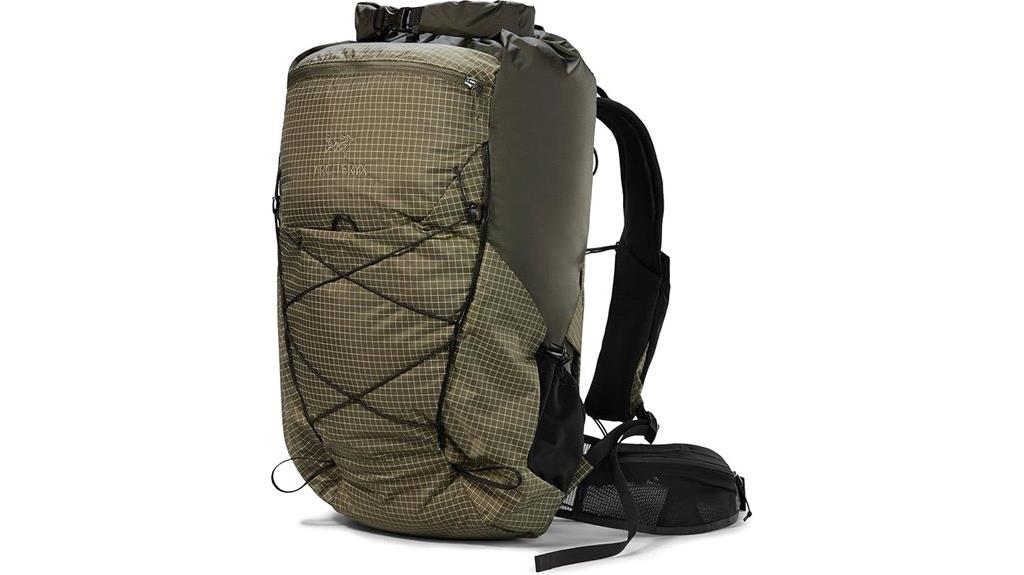
The Arc’teryx Aerios 35 represents precision engineering for ultralight enthusiasts who demand both minimal weight and maximum durability on extended day hikes or overnight adventures. At just 1 pound, this 35L pack utilizes proprietary 210D Hadron™ LCP fabric that delivers exceptional strength without bulk. You’ll appreciate the roll-top design that expands capacity to 45L when needed.
The patent-pending two-point harness system positions shoulder strap pockets effectively for 500mL soft flasks. The monofilament mesh hipbelt provides support while maintaining breathability. AeroForm back panel technology enhances comfort during long carries. Dual trekking pole attachment points and front bungee compression complete the technical feature set for serious ultralight backpacking.
Best For: Ultralight hikers and backpackers who prioritize minimal weight without sacrificing durability for day hikes and overnight adventures.
Pros:
- Exceptionally lightweight at just 1 pound while maintaining durability with proprietary Hadron™ LCP fabric
- Expandable capacity from 35L to 45L with roll-top design for variable load requirements
- Advanced comfort features including AeroForm back panel, breathable mesh hipbelt, and patent-pending harness system
Cons:
- Premium Arc’teryx pricing may be cost-prohibitive for casual hikers
- 35L base capacity may be limiting for longer multi-day trips requiring more gear
- Ultralight construction may not withstand heavy abuse compared to burlier expedition packs
Factors to Consider When Choosing an Ultralight Backpack
I’ll guide you through the critical factors that determine whether an ultralight backpack meets your hiking needs. The balance between weight savings and carrying capacity represents the fundamental challenge—you’re looking for packs under 2.5 pounds that still provide adequate volume for your gear load. Material durability, comfort systems, weather protection, and storage organization complete the evaluation framework that’ll help you select the right pack for your specific hiking style.
Weight Vs Capacity Balance
Although ultralight backpack selection requires careful consideration of multiple variables, weight versus capacity balance stands as the most critical factor determining your pack’s performance on the trail. I’ve found that lighter options sacrifice storage space considerably. A 20-liter pack weighing 2.5 ounces offers minimal gear capacity, while larger packs compromise weight savings. The capacity range spans from 18-liter minimalist daypacks to 60-liter expedition models, directly affecting overall weight and comfort.
Some ultralight packs weigh as little as 4 ounces, making them ideal for backcountry hiking where every ounce matters. However, you’ll lose internal compartments and organizational features. For day trips, I recommend 30-liter packs, but avoid models exceeding 2 pounds. Match your pack’s capacity to your intended activities while maintaining lightweight design principles for maximum trail performance.
Material Durability Standards
Beyond finding the right size-to-weight ratio, material durability standards determine whether your ultralight backpack survives demanding trail conditions or fails when you need it most. I recommend looking for high-tenacity fabrics like nylon and polyester that balance strength with minimal weight. Key specifications include tear resistance and abrasion resistance ratings. Materials such as 30D Cordura and UHMWPE blended textiles offer enhanced durability without significant weight penalties.
Water resistance proves critical for gear protection. Look for siliconizing processes or DWR finishes that repel moisture effectively. Construction quality matters equally. I prioritize reinforced seams and double-stitched joints that prevent wear-related failures during extended use. Additionally, bluesign approved and GRS-certified materials indicate environmental responsibility while maintaining performance standards you can trust on challenging trails.
Comfort and Fit
While durability protects your gear investment, comfort and fit determine whether you’ll actually enjoy carrying your ultralight backpack mile after mile. Weight matters most here. The Osprey Ultralight Stuff Pack weighs just 5.2 ounces, reducing fatigue during extended hikes.
I recommend seeking ergonomic features like tensioned mesh backpanels and AirSpeed™ technology. These systems improve ventilation and prevent overheating. Adjustable harness systems and hipbelts guarantee proper fit across different body types, providing stability and support where you need it most.
Material selection directly affects comfort. Nylon and silicone-coated fabrics minimize chafing while keeping weight low. Look for compression straps that stabilize your load and distribute weight evenly. This prevents shoulder and back strain, letting you focus on the trail ahead rather than discomfort.
Weather Resistance Features
When weather turns harsh on the trail, your backpack’s resistance features become the critical barrier between dry gear and a miserable hiking experience. I recommend examining three essential waterproofing elements before purchasing.
First, check the fabric construction. Silicone-treated nylon and ripstop materials offer superior water resistance while maintaining ultralight weight specifications. These fabrics typically provide 1,500-3,000mm waterproof ratings.
Second, evaluate seam construction. Sealed seams prevent water infiltration at stitch points, where most backpacks fail during heavy rainfall. Roll-top closures create watertight seals superior to traditional zippers.
Third, consider additional protection systems. Built-in rain covers and waterproof stuff sacks provide backup protection during sudden weather changes. However, verify the specific waterproof rating—some designs only withstand light precipitation while others offer complete submersion protection.
Storage and Organization
Three fundamental storage principles determine whether an ultralight backpack meets your organizational needs on extended trails. First, compartment design affects accessibility. Most ultralight packs feature single main compartments with minimal internal dividers, trading organization for weight savings. You’ll need strategic packing techniques to maintain order.
Second, external storage options enhance functionality. Side pockets and front panel access provide quick gear retrieval without unpacking your entire load. These features prove essential for water bottles, snacks, and navigation tools.
Third, securing loose items requires external systems. Compression straps and elasticized lacing prevent gear shifting while hiking. Without rigid internal frames, you’ll rely on packing cubes and stuff sacks for smaller items. This modular approach maintains organization while preserving the pack’s ultralight characteristics.
Price and Value
Beyond organizational features, budget considerations shape your ultralight backpack selection considerably. I evaluate price against weight metrics since lighter materials command premium costs. A pack weighing 1.5 pounds typically costs $200-400, while sub-pound models reach $500-600 due to specialized fabrics like Dyneema Composite.
Capacity directly impacts pricing. A 40-liter pack costs 20-30% more than a 30-liter equivalent from the same manufacturer. I balance space requirements against weight penalties to maximize value.
Customer reviews reveal long-term performance data that justifies initial investment. Well-rated packs demonstrate superior durability metrics over 500+ trail miles.
Essential features like waterproof coatings and compression systems add $50-100 but enhance functionality considerably. I prioritize warranties exceeding two years, as they indicate manufacturer confidence and reduce replacement costs.
Frequently Asked Questions
How Do I Properly Care for and Maintain My Ultralight Backpack?
I’ll explain proper ultralight backpack maintenance. Always air-dry your pack completely after each trip to prevent mold growth. Clean with mild soap and lukewarm water, avoiding harsh detergents that damage technical fabrics. Inspect zippers monthly and lubricate with specialized zipper wax. Check seam integrity regularly. Store loosely packed in cool, dry conditions. Replace worn buckles immediately to maintain load distribution efficiency.
What’s the Difference Between Ultralight and Traditional Backpack Materials?
I’ll explain the key material differences between ultralight and traditional backpacks. Traditional packs use heavy-duty fabrics like 500-1000 denier nylon or polyester, prioritizing extreme durability over weight. Ultralight packs employ 70-210 denier ripstop nylon with silicone or polyurethane coatings. They’re 40-60% lighter but less abrasion-resistant. Ultralight materials sacrifice some longevity for significant weight reduction, typically weighing 1-3 pounds versus traditional packs at 4-7 pounds.
Can Ultralight Backpacks Handle Multi-Day Hiking Trips Safely?
I’ll assure you that quality ultralight backpacks handle multi-day trips safely when you choose wisely. Modern ultralight materials like Dyneema Composite Fabric offer 200+ denier strength while weighing 50% less than traditional nylon. I recommend checking weight capacity ratings—most ultralight packs safely carry 30-35 pounds. The key lies in selecting packs with reinforced stress points and proven durability testing from established manufacturers.
How Much Weight Can I Realistically Save With an Ultralight Backpack?
I’ll help you calculate realistic weight savings with ultralight backpacks. Traditional hiking packs weigh 4-6 pounds, while ultralight models typically weigh 1-2.5 pounds. You’ll save 2-4 pounds immediately. That’s significant when every ounce counts on long trails. However, ultralight packs sacrifice some features like extra pockets, frames, and padding. The weight reduction directly translates to less strain on your back and increased hiking endurance over multiple days.
Are Ultralight Backpacks Suitable for Beginners or Just Experienced Hikers?
I recommend ultralight backpacks for beginners with specific conditions. You’ll need disciplined packing skills since these packs offer minimal organization features. Start with day hikes using ultralight gear to develop weight-conscious habits. Choose packs with 30-40L capacity and basic frame systems for forgiveness. I suggest gaining experience with traditional packs first if you’re prone to overpacking or need extensive gear redundancy for confidence.
On a final note
I’ve covered eight top ultralight backpacks spanning different capacities and use cases. You’ll find options from 18-liter day packs to 60-liter expedition models. Weight ranges from 2.5 ounces for collapsible packs to 3.2 pounds for full-frame designs. Consider your trip duration, gear volume, and weight tolerance when choosing. Frame type, fabric denier, and hydration compatibility directly impact performance. Select based on your specific hiking demands rather than brand preference.

